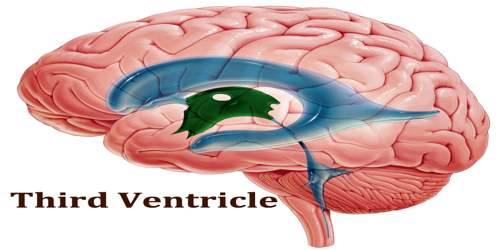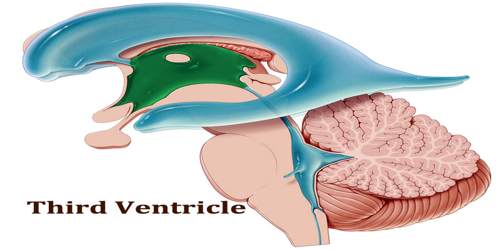Third Ventricle
Definition
Third ventricle is a median (midline) cavity in the brain and is bounded by the thalamus and hypothalamus on either side. It communicates anteriorly (in front) with the lateral ventricles, and posteriorly (in back) with the aqueduct of the midbrain, also known as the aqueduct of Sylvius. All the ventricles are filled with cerebrospinal fluid, which is formed by choroid plexuses, structures that are located in the walls and roofs of the ventricles.

The third ventricle is part of a network of linked cavities (cerebral ventricles) in the brain that extend to form the central canal of the spinal cord. The cerebral ventricles consist of the lateral ventricles, third ventricle, and fourth ventricle. It contains cerebrospinal fluid, which is produced by specialized epithelium located within the ventricles called the choroid plexus.
The third ventricle is situated in the middle of the cerebral hemispheres, between the right and left lateral ventricles. The third ventricle is inferior to the fornix and corpus callosum.
Structure and Functions of Third Ventricle
Third ventricle is one of the four ventricles in the brain that communicate with one another. As with the other ventricles of the brain, it is filled with cerebrospinal fluid, which helps to protect the brain from injury and transport nutrients and waste. The third ventricle is a narrow cavity that is located between the two halves of the brain.
The third ventricle is bounded by the thalamus and hypothalamus on both the left and right sides. The lamina terminalis forms the anterior wall. The floor is formed by hypothalamic structures. The roof is formed by the ependyma, lining the undersurface of the tela choroidea of the third ventricle.

There are two protrusions on the anterior aspect of the third ventricle:
- The supra-optic recess (above the optic chiasma)
- The infundibular recess (above the pituitary stalk).
The third ventricle sends messages to and receives messages from the lateral ventricles, which are located in front of the third ventricle, and the aqueduct of the midbrain, which is located directly behind the third ventricle. The hypothalamus and thalamus are located on the sides of the third ventricle.
The third ventricle is involved in several functions of the body including:
- Protection of the Brain From Trauma
- Pathway for the Circulation of Cerebrospinal Fluid
- Transportation of Nutrients to and Waste from the Central Nervous System
Reference:
















